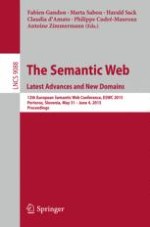This book constitutes the refereed proceedings of the 12th Extended Semantic Web Conference, ESWC 2014, held in Anissaras, Portoroz, Slovenia, in May/June 2015. The 43 revised full papers presented together with three invited talks were carefully reviewed and selected from 164 submissions. This program was completed by a demonstration and poster session, in which researchers had the chance to present their latest results and advances in the form of live demos. In addition, the PhD Symposium program included 12 contributions, selected out of 16 submissions. The core tracks of the research conference were complemented with new tracks focusing on linking machine and human computation at web scale (cognition and Semantic Web, Human Computation and Crowdsourcing) beside the following subjects Vocabularies, Schemas, Ontologies, Reasoning, Linked Data, Semantic Web and Web Science, Semantic Data Management, Big data, Scalability, Natural Language Processing and Information Retrieval, Machine Learning, Mobile Web, Internet of Things and Semantic Streams, Services, Web APIs and the Web of Things, Cognition and Semantic Web, Human Computation and Crowdsourcing and In-Use Industrial Track as well.
